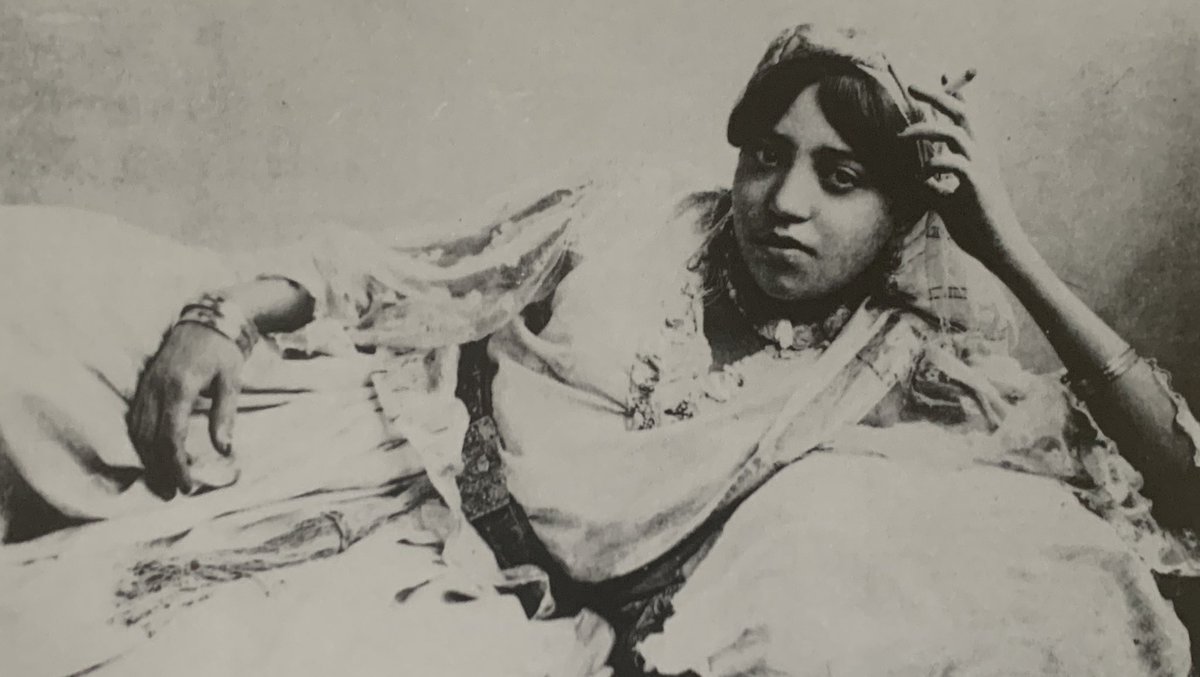
Unveiling Algerian women: how French photographers turned the Algérienne into an orientalist fantasy to further France’s colonial project
A thread ✨
sacredfootsteps.org/2021/03/21/unv…
A thread ✨
sacredfootsteps.org/2021/03/21/unv…
When the French occupied Algeria, they took hundreds of photos between 1900-30. They were printed as postcards and distributed in France. 

But the photographer faced a problem. Algerian women and home life were not accessible to him. Algerian women typically dressed like this in public, defying the photographer’s gaze 

And so the colonial photographer came up with a solution; if the Algerian woman was not accessible to him, he would ‘create’ her instead 

French colonial photographers hired women from the margins of society, dressed and undressed them accordingly, and created a colonial fantasy on camera 

The fantasy of the ‘harem’, where reclining odalisks, often topless, fulfilled the desires of the European (male) spectator 

These ‘harem’ photos were based on the imagery found in European orientalist paintings of the harem, which were never based on reality but were figment of the imagination 

The Algerian woman was represented as sexually available (image 1), naked for no reason (2), at times bizarrely so (3) 





The political & ideological context in which the photos were taken also cannot be ignored; French colonisers quickly politicised the veil, actively using the ‘unveiling’ of the Algerian woman to break the Algerian resistance 



Frantz Fanon: “The officials of the French administration in Algeria, committed to destroying the people’s originality...were to concentrate their efforts on the wearing of the veil, which was looked upon at this juncture as a symbol of the status of the Algerian woman.” 

“Every veil that fell...every face that offered itself to the bold and impatient glance of the occupier, was a negative expression of the fact that Algeria was beginning to deny herself and was accepting the rape of the colonizer.” Fanon 

By daring to defy the coloniser’s insatiable need to observe, the Algérienne, in her absence, was deconstructed and re-created by that most duplicitous operative of the coloniser’s regime, the photographer. 

The Algérienne was substituted, unveiled and turned into a fantasy long dreamed up by a Europe who used her body to help define its ideological ‘other.’ 

That these images, constructed with a clear intent to objectify & eroticise its subjects, offered Europe one of its 1st ever photographic encounters of the Algerian or Muslim woman, makes clear the French photographer’s complicity in furthering an orientalist ideological agenda 

His deliberate staging of the photographs, an intervention that went far beyond normal aesthetic concerns (such as lighting), and the attempts to suggest an ethnographic interest, means that he cannot be absolved on the basis of artistic licensing. 

The politicising of the veil by French authorities within Algeria, and the ideological attachment ‘unveiling’ subsequently carried, further implicates these photographs, even if only in hindsight, as an ideological tool of the French colonial authorities.
For full analysis & sources read:
Unveiling the Algérienne: French Colonial Photography by @ZaraChoudharyX
sacredfootsteps.org/2021/03/21/unv…
Unveiling the Algérienne: French Colonial Photography by @ZaraChoudharyX
sacredfootsteps.org/2021/03/21/unv…
• • •
Missing some Tweet in this thread? You can try to
force a refresh


